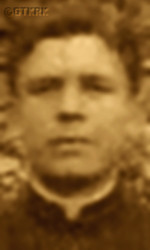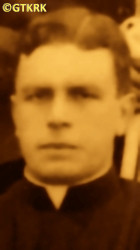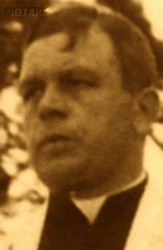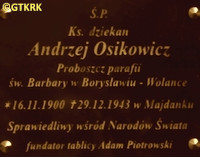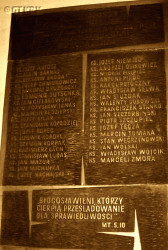Roman Catholic
St Sigismund parish
05-507 Słomczyn
85 Wiślana Str.
Konstancin deanery
Warsaw archdiocese, Poland
full list:
displayClick to display full list

searchClick to search full list by categories
wyświetlKliknij by wyświetlić pełną listę po polsku

szukajKliknij by przeszukać listę wg kategorii po polsku

Martyrology of the clergy — Poland
XX century (1914 – 1989)
personal data
surname
OSIKOWICZ
surname
versions/aliases
OSIKIEWICZ
forename(s)
Andrew (pl. Andrzej)
function
diocesan priest
creed
Latin (Roman Catholic) Church RCmore on
en.wikipedia.org
[access: 2014.09.21]
diocese / province
Przemyśl diocesemore on
www.przemyska.pl
[access: 2013.02.15]
honorary titles
Expositorii Canonicalis canonmore on
Expositorii Canonicalis canon
(c. 1934)
„Polonia Restituta” Cross — 3rd Class, Commander'smore on
„Polonia Restituta” Cross – 3rd_Class, Commander's
(08.03.2016)
Righteous Among the Nationsmore on
Righteous Among the Nations
(09.08.1995)
date and place
of death
29.12.1943

KL Lublinconcentration camp
today: Majdanek‐Lublin, Lublin city pov., Lublin voiv., Poland
more on
en.wikipedia.org
[access: 2022.01.09]
details of death
After German and Russian invasion of Poland in 09.1939 and start of the World War II arrested his parish got under Russian occupation.
Survived large deportations in 1939‐1941 of Poles to Siberia.
After German attack of their erstwhile Russian ally on 22.06.1941 took Boryslav magistrates' stamps and documents into deposit. After arrivals of Germans returned them back, not without however preparing and hiding many blank documents prior to handing stamps, etc.
over to the Germans.
During German occupation urged his parishioners to help persecuted Jewish neighbours.
Forged documents proving „Aryan” origin of the protected Jews.
Saved Jewish children sheltering them in Catholic monasteries and at Catholic families.
Helped Poles and Jews alike leading the activities of Polish committee of Central Welfare Council RGO in Boryslav — the only charitable organization in German Germ. Generalgouvernement (Eng. General Governorate) allowed to function.
Arrested by the Germans in 01.1943, denounced by collaborationst Ukrainian Germ. Ukrainische Hilfspolizei (Eng. Ukrainian Auxiliary Police). Just before arrest, managed to destroy the parish books so that the Germans could not verify the false birth certificates he had issued to the Jews in hiding.
The witness remembered that his last words to those present during the arrest of the parishioner were: „I apologize to everyone, to those whom I may have somehow offended. I will not return…”.
Held in Drohobych prison.
In 02.1942 transported to KL Majdanek concentration camp where perished prob. from typhoid.
Posthumously honoured by Jewish state as „Righteous among the nations”.
prisoner camp's numbers
8928 (KL Lublin (Majdanek)Click to display the description)
cause of death
extermination
perpetrators
Germans
sites and events
KL Lublin (Majdanek)Click to display the description, Help to the JewsClick to display the description, GeneralgouvernementClick to display the description, Deportations to SiberiaClick to display the description, Ribbentrop‐MolotovClick to display the description, Pius XI's encyclicalsClick to display the description
date and place
of birth
16.11.1900

Kobylankatoday: Gorlice gm., Gorlice pov., Lesser Poland voiv., Poland
more on
en.wikipedia.org
[access: 2021.10.09]
parents
OSIKOWICZ John
🞲 ?, ? — 🕆 ?, ?

DUSZA Apolonia
🞲 ?, ? — 🕆 ?, ?
presbyter (holy orders)
ordination
27.05.1923

Przemyśltoday: Przemyśl city pov., Subcarpathia voiv., Poland
more on
en.wikipedia.org
[access: 2021.04.01]
Assumption of the Blessed Virgin Mary and St John the Baptist RC cathedral churchmore on
en.wikipedia.org
[access: 2025.03.14]
positions held
1936 – 1943
dean — Drohobychtoday: Drohobych urban hrom., Drohobych rai., Lviv obl., Ukraine
more on
en.wikipedia.org
[access: 2021.10.09] RC deanery
1931 – 1943
parish priest — Boryslavtoday: Boryslav urban hrom., Drohobych rai., Lviv obl., Ukraine
more on
en.wikipedia.org
[access: 2020.11.01] ⋄ St Barbara the Virgin and Martyr RC parish ⋄ Drohobychtoday: Drohobych urban hrom., Drohobych rai., Lviv obl., Ukraine
more on
en.wikipedia.org
[access: 2021.10.09] RC deanery — also: founder of the Christ the King (1934) and the Blessed Virgin Mary, Queen of Poland (1936) churches in Boryslav
1928 – 1931
vicar — Tustanovychitoday: district of Boryslav, Boryslav urban hrom., Drohobych rai., Lviv obl., Ukraine
more on
en.wikipedia.org
[access: 2020.11.01] ⋄ St Barbara the Virgin and Martyr RC parish ⋄ Drohobychtoday: Drohobych urban hrom., Drohobych rai., Lviv obl., Ukraine
more on
en.wikipedia.org
[access: 2021.10.09] RC deanery
1926 – 1928
vicar — Stoyantsitoday: Mostyska urban hrom., Yavoriv rai., Lviv obl., Ukraine
more on
uk.wikipedia.org
[access: 2023.03.02] ⋄ Blessed Virgin Mary of Mount Carmel RC parish ⋄ Sudova Vyshnyatoday: Sudova Vyshnya urban hrom., Yavoriv rai., Lviv obl., Ukraine
more on
en.wikipedia.org
[access: 2021.05.06] RC deanery
1926
vicar — Czudectoday: Czudec gm., Strzyżów pov., Subcarpathia voiv., Poland
more on
en.wikipedia.org
[access: 2021.10.09] ⋄ Holy Trinity RC parish ⋄ Strzyżówtoday: Strzyżów gm., Strzyżów pov., Subcarpathia voiv., Poland
more on
en.wikipedia.org
[access: 2021.10.09] RC deanery
1925 – 1926
administrator — Błażowatoday: Błażowa gm., Rzeszów pov., Subcarpathia voiv., Poland
more on
en.wikipedia.org
[access: 2021.05.06] ⋄ St Martin the Bishop and Confessor RC parish ⋄ Tyczyntoday: Tyczyn gm., Rzeszów pov., Subcarpathia voiv., Poland
more on
en.wikipedia.org
[access: 2021.05.06] RC deanery
1923 – 1925
vicar — Błażowatoday: Błażowa gm., Rzeszów pov., Subcarpathia voiv., Poland
more on
en.wikipedia.org
[access: 2021.05.06] ⋄ St Martin the Bishop and Confessor RC parish ⋄ Tyczyntoday: Tyczyn gm., Rzeszów pov., Subcarpathia voiv., Poland
more on
en.wikipedia.org
[access: 2021.05.06] RC deanery
1919 – 1923
student — Przemyśltoday: Przemyśl city pov., Subcarpathia voiv., Poland
more on
en.wikipedia.org
[access: 2021.04.01] ⋄ philosophy and theology, Theological Seminary
others related
in death
ARCHUTOWSKIClick to display biography Roman, CHŁOPECKIClick to display biography Romualdo, KAŚCIŃSKIClick to display biography Leopold, KOWCZClick to display biography Emilian, KOZŁOWSKIClick to display biography Valery, LESZCZYKClick to display biography Anthony, MODRZEWSKAClick to display biography Hedwig Joanna Gabrielle, NIEROSTEKClick to display biography Joseph, PECIAKClick to display biography Louis, TROCHAClick to display biography Peter (Bro. Adalbert Marian)
sites and events
descriptions
KL Lublin (Majdanek): Operational in 1941‐1944, in Majdanek village n. Lublin, German Germ. Konzentrationslager (Eng. concentration camp) KL and „death” camp. Prisoners were not only local, from Lublin region, but from all over pre‐war Poland and from abroad. Most of them were Jewish, but also member of Polish clandestine resistance (part of Polish Clandestine State), Polish intelligentsia, Russian POWs, inhabitants of Zamość area evicted by the Germans, people captured in round‐ups in Polish towns and cities. 6% of the prisoners were children 14 years old and younger. Prisoners slaved at c. 16 sub‐camps working for German companies, such as Deutsche Ausrüstungswerke (DAW). Altogether c. 150,000 people were held in the camp. C. 79,000 victims were murdered, among them c. 59,000 Jews. The camp was equipped with 5 gas chambers, where prisoners were mass murdered, using gas from bottles or from capsules of Zyklon B. (more on: www.majdanek.euClick to attempt to display webpage
[access: 2012.11.23], en.wikipedia.orgClick to attempt to display webpage
[access: 2013.08.10])
Help to the Jews: During World War II on the Polish occupied territories Germans forbid to give any support to the Jews under penalty of death. Hundreds of Polish priests and religious helped the Jews despite this official sanction. Many of them were caught and murdered.
Generalgouvernement: After the Polish defeat in the 09.1939 campaign, which was the result of the Ribbentrop‐Molotov Pact and constituted the first stage of World War II, and the beginning of German occupation in part of Poland (in the other, eastern part of Poland, the Russian occupation began), the Germans divided the occupied Polish territory into five main regions. In two of them new German provinces were created, two other were incorporated into other provinces. However, the fifth part was treated separately, and in a political sense it was supposed to recreate the German idea from 1915 (during World War I, after the defeat of the Russians in the Battle of Gorlice in 05.1915) of creating a Polish enclave within Germany. Illegal in the sense of international law, i.e. Hague Convention, and public law, managed by the Germans according to separate laws — especially established for the Polish Germ. Untermenschen (Eng. subhumans) — till the Russian offensive in 1945 it constituted part of the Germ. Großdeutschland (Eng. Greater Germany). Till 31.07.1940 formally called Germ. Generalgouvernement für die besetzten polnischen Gebiete (Eng. General Government for the occupied Polish lands) — later simply Germ. Generalgouvernement (Eng. General Governorate), as in the years 1915‐1918. From 07.1941, i.e. after the German attack on 22.06.1941 against the erstwhile ally, the Russians, it also included the Galicia district, i.e. the Polish pre‐war south‐eastern voivodeships. A special criminal law was enacted and applied to Poles and Jews, allowing for the arbitrary administration of the death penalty regardless of the age of the „perpetrator”, and sanctioning the use of collective responsibility. After the end of the military conflict of the World War UU, the government of the Germ. Generalgouvernement was recognized as a criminal organization, and its leader, governor Hans Frank, guilty of war crimes and crimes against humanity and executed. (more on: en.wikipedia.orgClick to attempt to display webpage
[access: 2024.12.13])
Deportations to Siberia: In 1939‐1941 Russians deported — in four large groups in: 10.02.1940, 13‐14.04.1940, 05‐07.1940, 05‐06.1941 — up to 1 mln of Polish citizens from Russian occupied Poland to Siberia leaving them without any support at the place of exile. Thousands of them perished or never returned. The deportations east, deep into Russia, to Siberia resumed after 1944 when Russians took over Poland. (more on: en.wikipedia.orgClick to attempt to display webpage
[access: 2014.09.21])
Ribbentrop‐Molotov: Genocidal Russian‐German alliance pact between Russian leader Joseph Stalin and German leader Adolf Hitler signed on 23.08.1939 in Moscow by respective foreign ministers, Mr. Vyacheslav Molotov for Russia and Joachim von Ribbentrop for Germany. The pact sanctioned and was the direct cause of joint Russian and German invasion of Poland and the outbreak of the World War II in 09.1939. In a political sense, the pact was an attempt to restore the status quo ante before 1914, with one exception, namely the „commercial” exchange of the so‐called „Kingdom of Poland”, which in 1914 was part of the Russian Empire, fore Eastern Galicia (today's western Ukraine), in 1914 belonging to the Austro‐Hungarian Empire. Galicia, including Lviv, was to be taken over by the Russians, the „Kingdom of Poland” — under the name of the General Governorate — Germany. The resultant „war was one of the greatest calamities and dramas of humanity in history, for two atheistic and anti‐Christian ideologies — national and international socialism — rejected God and His fifth Decalogue commandment: Thou shall not kill!” (Abp Stanislav Gądecki, 01.09.2019). The decisions taken — backed up by the betrayal of the formal allies of Poland, France and Germany, which on 12.09.1939, at a joint conference in Abbeville, decided not to provide aid to attacked Poland and not to take military action against Germany (a clear breach of treaty obligations with Poland) — were on 28.09.1939 slightly altered and made more precise when a treaty on „German‐Russian boundaries and friendship” was agreed by the same murderous signatories. One of its findings was establishment of spheres of influence in Central and Eastern Europe and in consequence IV partition of Poland. In one of its secret annexes agreed, that: „the Signatories will not tolerate on its respective territories any Polish propaganda that affects the territory of the other Side. On their respective territories they will suppress all such propaganda and inform each other of the measures taken to accomplish it”. The agreements resulted in a series of meeting between two genocidal organization representing both sides — German Gestapo and Russian NKVD when coordination of efforts to exterminate Polish intelligentsia and Polish leading classes (in Germany called «Intelligenzaktion», in Russia took the form of Katyń massacres) where discussed. Resulted in deaths of hundreds of thousands of Polish intelligentsia, including thousands of priests presented here, and tens of millions of ordinary people,. The results of this Russian‐German pact lasted till 1989 and are still in evidence even today. (more on: en.wikipedia.orgClick to attempt to display webpage
[access: 2015.09.30])
Pius XI's encyclicals: Facing the creation of two totalitarian systems in Europe, which seemed to compete with each other, though there were more similarities than contradictions between them, Pope Pius XI issued in 03.1937 (within 5 days) two encyclicals. In the „Mit brennender Sorge” (Eng. „With Burning Concern”) published on 14.03.1938, condemned the national socialism prevailing in Germany. The Pope wrote: „Whoever, following the old Germanic‐pre‐Christian beliefs, puts various impersonal fate in the place of a personal God, denies the wisdom of God and Providence […], whoever exalts earthly values: race or nation, or state, or state system, representatives of state power or other fundamental values of human society, […] and makes them the highest standard of all values, including religious ones, and idolizes them, this one […] is far from true faith in God and from a worldview corresponding to such faith”. On 19.03.1937, published „Divini Redemptoris” (Eng. „Divine Redeemer”), in which criticized Russian communism, dialectical materialism and the class struggle theory. The Pope wrote: „Communism deprives man of freedom, and therefore the spiritual basis of all life norms. It deprives the human person of all his dignity and any moral support with which he could resist the onslaught of blind passions […] This is the new gospel that Bolshevik and godless communism preaches as a message of salvation and redemption of humanity”… Pius XI demanded that the established human law be subjected to the natural law of God , recommended the implementation of the ideal of a Christian state and society, and called on Catholics to resist. Two years later, National Socialist Germany and Communist Russia came together and started World War II. (more on: www.vatican.vaClick to attempt to display webpage
[access: 2023.05.28], www.vatican.vaClick to attempt to display webpage
[access: 2023.05.28])
sources
personal:
www.glaukopis.plClick to attempt to display webpage
[access: 2012.11.23], represje.iss.krakow.plClick to attempt to display webpage
[access: 2016.03.14], boryslavrada.gov.uaClick to attempt to display webpage
[access: 2025.08.19], om.io.uaClick to attempt to display webpage
[access: 2013.08.17], www.majdanek.euClick to attempt to display webpage
[access: 2013.08.17]
bibliographical:
„Register of Latin rite Lviv metropolis clergy’s losses in 1939‐45”, Józef Krętosz, Maria Pawłowiczowa, editors, Opole, 2005
„Biographical lexicon of Lviv Roman Catholic Metropoly clergy victims of the II World War 1939‐1945”, Mary Pawłowiczowa (ed.), Fr Joseph Krętosz (ed.), Holy Cross Publishing, Opole, 2007
„Schematismus Venerabilis Cleri Dioecesis PremisliensisClick to display source page”, Przemyśl diocesa Curia, from 1866 to 1938
„Mysterium iniquitatis. Clergy and religious of the Latin rite murdered by Ukrainian nationalists in 1939‐1945”, Fr Józef Marecki, Institute of National Remembrance IPN, Kraków 2020
original images:
twitter.comClick to attempt to display webpage
[access: 2017.03.24], boryslavrada.gov.uaClick to attempt to display webpage
[access: 2025.08.19], twitter.comClick to attempt to display webpage
[access: 2017.03.24], boryslavrada.gov.uaClick to attempt to display webpage
[access: 2025.08.19], www.miejscapamiecinarodowej.plClick to attempt to display webpage
[access: 2014.08.14]
LETTER to CUSTODIAN/ADMINISTRATOR
If you have an Email client on your communicator/computer — such as Mozilla Thunderbird, Windows Mail or Microsoft Outlook, described at WikipediaPatrz:
en.wikipedia.org, among others — try the link below, please:
LETTER to CUSTODIAN/ADMINISTRATORClick and try to call your own Email client
If however you do not run such a client or the above link is not active please send an email to the Custodian/Administrator using your account — in your customary email/correspondence engine — at the following address:

giving the following as the subject:
MARTYROLOGY: OSIKOWICZ Andrew
To return to the biography press below:
 Click to return to biography
Click to return to biography








